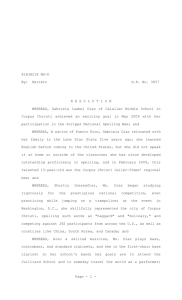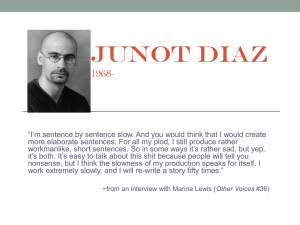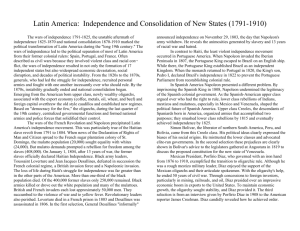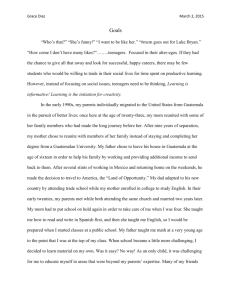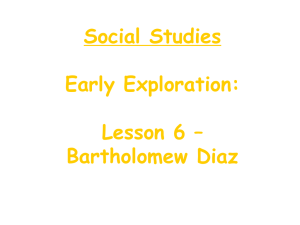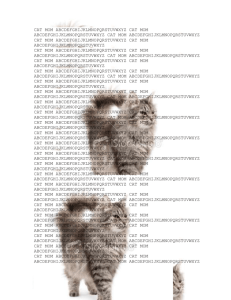Junot Diaz's Drown:
advertisement
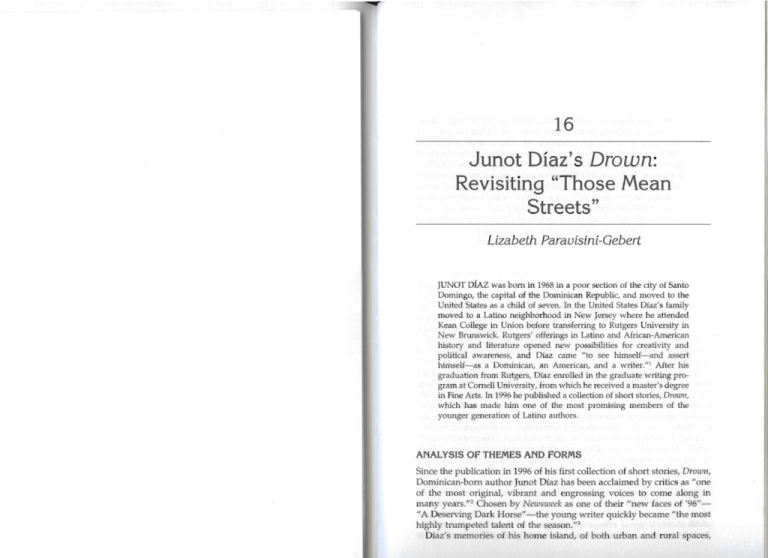
16 Junot Diaz's Drown: Revisiting "Those Mean Streets" Lizabeth Parav isini-Gebert JUNOT DIAZ wa s born in 1968 in a poor section of the city of Santo Domingo, the capital of the Dominic an Rep ublic, and moved to the United States as a child of seven . In the United States Dfaz's family moved to a Latino neig hbo rhood in New Jersey w here he attended Kean College in Union before transferring to Rutgers Univer sity in New Brunswick. Rutgers' offerings in Latino and African-American history an d literatu re opened new possibilities for crea tivity and po litical awareness, an d Diaz came "to see himself- an d assert himself- as a Dominican , an Am erican, and a writer.'" After his graduation from Rut gers, Dfaz enrolled in the graduate writing pro­ gram at Corne ll University, from which he received a master's degree in Fine Arts. In 1996 he published a collection of short stories, Drown, which has made him one of the most promising memb ers of the younger generati on of Latino authors. ANALYSIS OF THEMES AN D FO RMS Since the publication in 1996 of his first collection of short stories, Drown, Dominican-born author [unot Diaz has bee n acclaimed by critics as "one of th e most original, vibrant and engrossing voices to come along in many years."? Chosen by Newsweek as one of th eir "new faces of '96"­ "A Deserving Dark Horse"- the young writer quickly became "the most highly trumpeted talen t of the seas on."? Dfaz's memories of his home islan d, of both ur ban an d rural spaces, ~ 164 u.s. Latino Literature are faint, "like the fixed image of photographs . . . [t]here is a snapshot of his childhood house, or a kung fu m ovie he once saw dubbed in Spanish, or a visit to Haiti,"! but they reverberate in his autobiogra phical stories as sparse but eloquent elements of a landscape of mem ory and experience. Diaz's narrative space, however, is do minated not by nostalgic recre­ ations of idealized childhood landscapes, but by the blea k, barren, and decayed margins of New Jersey's inner cities. Diaz, whom critics have pra ised for his acute powers of observation, has a sharp eye for the social and human blight that has resulted from urban neglect. The trajectory of his characters' lives mirrors Diaz's own observatio ns an d expe riences in this setting. The New Jersey he writes about, as he told one inter­ viewer, "is the one he kn ows : a place of blue-collar towns of Latin o immigrants, of tostones (mashed fried plantains ) and malls and roads where 'beer bottles grow out of the we ed s like squashes.' " 5 His own family wa s not immune to the destructive aspects of this ne w environ­ men t- his father, somew ha t of a wo manizer, abandoned the family for ano ther wo man when Diaz was an ad olescen t, an d his mother, with he r insufficient kn owle dge of English, could find only sub standar d employ­ ment. Diaz learned early to escape his unpromising circumstances through . writing. He began to w rite in earnest as a high school sophomore when his older brother, Rafael, wa s diagnosed with leuk emi a an d was ho spi­ talized. Diaz "spent his days scribbling long letters to Rafa.:" He found another avenue of escape thr ough education by attending Kean College an d later transferring to Rutgers University in New Brunswick. After gra dua tion from Rutgers, Diaz enrolled in the graduate writing program at Cornell University. The ma rketing of Diaz's stories read s like a cautionary tale about the commodification of Latin o literature, its literary merit notwi thstanding. He erup ted into the public notice quite dramatically with a blitz of p ub ­ licity following the announc em ent of his ha ving received "gobs of money" for his first collection of short stories and a novel he had not yet started. The story of the feeding frenzy that led to his receiving "six figures" from Riverhead Books ha s the fascination of the proverbial train wreck. If the tale of his discovery by Rosenthal recalls that of Lana Turner's own discovery at Schwab's Drugstore in its serendipity and improbability, that of the reading at the KGB Bar in the East Village to an audience packed wi th talen t scouts arranged by Rosenthal, an d the subsequent summoning of eight p ublishing houses to wrestle for the rig hts to publish the bo ok, speak of the fury to bring 'selected Latino voices to a market avid for marketable minority voices. The publication of his short stories in venues as prestigiou s as the New Yorker an d the Paris Review soon attracted even more no tice, placing Diaz in an almost Revisiting "Those Mean Streets" 165 untenable situation of having to meet the highest and most overblown expectations. His inclus ion in two conse cutive collections of The Best American Short Stories ("Ysrael" in 1996 an d "Fiesta, 1980" in 1997) attests to the p rofound impact he has made on the Ame rican literary scene since the pub lication of Drown. Like Toni Morrison, whos e novels chronicle th e black Ame rican ex­ perience, focusing on how characters struggle to find themselves and assert thei r cultural id entity against an unjust society, Diaz is interested in narrating the great h uman loss of marginalization and closed options. Unli ke Morrison, however, whose use of fan tasy and highly po etic style lifts her characters toward the symbolic and mythic, Diaz is more con­ cerned with depicting the petty humiliations and everyday deprivations of inner-city life. He is closer in outlook an d sty le to two writers to whom he is frequently compared: Pu erto Rican author Piri Thomas and Lang­ ston Hughes, both of whom are known for their eloquent po rtrayal of ghetto you th stru ggling against the conditions of life for urban black an d Hisp anic youth. Thomas' Down These Mean Streets (1967), in particular, comes to mind when linking Drown to a literary tradition. In ma ny w ays Drown is a sort of throwback to the Nuyorican literature of the 1950s and 1960s. Thomas' classic of Latino anguish and despair was the first in a trad ition of hea rt­ wrenching memoirs dep ictin g the destruction of the Puerto Rican soul in the American ghetto . The text dissected in hars h detail the dru g­ pe ddling culture, the devastation caused by heroin addiction, the bru­ tality of prison life, the loss of the savi ng power of faith and family, and the constan t struggle aga inst the diminishing value of life th at were part of the 1960s as lived by the young Puerto Rican community of Spanish Harlem. Diaz's Drown, though removed in tim e an d spa ce from Thomas' barrio, nonetheless revisits many of its themes and mo tifs, updating for a new audience, in a trimmed-down, more detached style, the vicissi­ tudes of young immigran t life in the inner city. Drown chronicles the human cost of an immigrant people's dis placement in an env ironment of cultural and racial discrimination and economic exploitation. The tra it that separates Diaz' s work from this earlier tradition is the absence of a clear political intent ion, which is mo st obvi ous in the pas­ sionate, denunciatory sty le of Piri Thomas' work as com pared to Diaz's cool, detached, minimalist prose. If Down These Mean Streets was a book of searing accusation against those forces in American society th at con­ demned some ethnic minorities to alienation, discrimina tion, and disil­ lusionment, it was also a book that assumed tha t these conditions could be altered through political action an d consciousness-raising. There is no su ch faith in concerted comm unity action in Drown; there is, as a matter of fact, little semblance of a com munity-in the sense of groups living lives of multileveled com munication with each other. There are friends 166 u.s. Latino Literature and neighbors w ho come across each other from time to time in these tales, but they merge and separate, like the proverbial shi ps that pass in the night, leavin g little in the ir wake. Jam es Wood s, in his review for the New Republic, accurately points to the stories "skill fully" catching Dfaz's characters "in th eir own glue of confusion, unable or unwilling to ch an ge any thing. "7 Drown opens w ith an epigraph from Cuban w riter Gustavo Perez Fir­ mat-"The fact that I am w riting to you in English already falsifies w ha t I wanted to tell yo u" -a poignant stateme nt affirming the cen trality of language to a w riter's unde rstanding and articulation of experience. The ep igraph, which bemoans Perez Firmat's sense of loss of his "na tural" [Spani sh] lan gu age, annou nces Diaz's subject to be tha t of explaining that he does not "b elong to Eng lish though I be long no wh ere else." Its use in Drown sets up a cu rious paradox for Diaz's w ork, which d oes not dwell wi th p articular pathos on his various im migran t characters' yearn ­ ing for a lost home or langu age or on their removal from their pl ace of origin. In fact, Spanish has little im pact on the stories in Drown; the texts m ay be p eppered wi th unexp lained and untrans lated Spanish words, many of w hich are misspelled or ar e used in gra mmatically incorrect va ria­ 'tions, They ar e no t broug ht into the text to enrich the Eng lish langu ag e with new exp ress ive possibilities, but as a re-crea tion of the easy slan g of the minority community ab out which he writes ." This community's alienation and exile come from its ma rginalization from mainstre am, mid dle-class American society, from a dis empowerment tha t is en de mic to nationa l and im migr ant mino rities in the United States, and d oes no t necessarily stem from a forced disconnectio n fro m the native language an d environment. The characters in Drown bel ong quite comfortab ly in an English vern acu lar wrought out of th e Latin o com m unity's experi­ ences in the three de cades that hav e elap sed since Thomas' work was initially publish ed . . The element that sets Drown apart from othe r texts abo ut immigran t life in the Ame rican inner city is a pointed and succinct, almost mini­ malist, style that is p urged of any tendency to rhetorical flights of fanc y, despite occasional lapses into questiona ble metaphors in describing the gri tty landscap e in which the various characters w ait ou t their lives. On the w ho le, howe ver, reviewers and readers ag ree tha t the collection's true originality lies in having created "a non-literary vernacular, com­ pounded of African American slang, loosened Spanish an d standard American storytelling" for his "cool an d grimy" p ortrayals of contem­ porary urba n America ." In discussions of Dtaz's spare language and sty le in Drown, much at­ tention has been given to the impact of the lack of quo tation marks or Revisiting "Those Mean Streets" 167 ita lics to identify dialogue or his use of four-lette r words as part of his appeal "as an authentic voice of his community."! " There is in this merg­ ing of voices, in this lack of distinction between narration and dialogue in Diaz's spare sentences, a brittleness that mirrors the bleakness and misery of the lives portrayed . Diaz claims to write "fo r the pe ople he grew up with," in the language of immigrant adolescents w ith no desire to learn from or about the world. He claims for his book an authenticity of observation untainted by a desire to explain his world to outsiders: "I too k extreme pains for my book to not be a native informant. Not: 'This is Domin ican food. This is a Spa nish word.' I trust my readers, even non-Spanish ones."!' The reader unfamiliar with the milieu de­ p icted in Drown must en ter this wo rld w ithout a guide since neither narrator no r characters will explain or justify themselves. There is in this first collection of stories, as there is in every first work, the stamp of a craft in the making, which, in the case of Drown, surfaces as the still-too-clear mark of professional writing programs like the one Diaz attended at Cornell. We can glimpse it in the only partly successful experiment with the imperative voice in "How to Date ..." in a distrust of third-person narrative even when, as is "Edison, New Jersey," it could serve the narrative better; and in the too-faithful adherence to closely examined models. The best of these stories, nonetheless, surmount what James Wood has described as "the contemporary idea of the short story, as processed by writing programs, that it must present itself as a victim of its own confusion, as a bew ilderment, a fragment,"1 2 and point to Dfaz's exceptional promise as a writer. All of the sto ries in Drown, w ith the exception of "No Face," are nar­ rated in the first person, w hich attests to their autobiographical natu re. Drown, although not autobiography per se, is clearly an autobiographical book; the stories have their basis in Diaz's own experiences growing up in the Dominican Republic and, after age seven, in a tough Latino neigh­ borhood in Perth Amboy. Five of the stories in Drown share the same narrator, the author's alter ego, Ram6n de las Casas, known as Yunior, a young boy whose narratives of a somewhat blighted Dominican child­ hood become the tales of a rather traumatized inner-city New Jersey adolescent. In the New Jersey- based stories, the narrators, all of whom mayor may not be Yunior, share Yunior's sensibility: the suspicious watchfulness and defensive stance, the blighted relationship with the father figure, and the uneasiness in relationships with women, which move from tenderness to violence. Thematically, the stories in Drown center on the de p rivation and te­ dium of life in the Dominican countryside and New Jersey: young chil­ d ren torture a deformed child in "Ysrael"; pe tty drug dealers languidly look for clients seeking to score in "Aurora"; days are spent searching 168 U.S. Latino Literatu re for bargains in the mall in "Drown"; children vomit in cars while trav­ eling to the Bronx to visit relatives in "Fiesta, 1980." Herein lies the strength- and occasiona lly the limitations-of these tales. In "Ysrael," the story tha t opens the book, Yunior and his brother Rafa, exiled by their mother to the Dominican countrysid e du ring their sum­ mer vacation, look at the verdant landscape surroundin g them, "at the mists that gathered like water, at the bru cal trees tha t blazed like fires on the mountains," and declare it to be "shit"-"worse than shit. "13This blank assertion sets the tone for the story of their dogged pursu it of a young deformed boy whose mask they wan t to remove to see the extent of his deformi ty. This, one of the most successful tales in the collection, works around two sets of failed connections- Yunior and Rafa/Yunior and Ysrael-and tw o failed qu ests- Rafa's searc h for sexual fulfillment and the search for the meaning behind Ysrael's horrible mutilation. Both quests are empty from the start-"worse than shit." Their purs uit of Ysrael- cruel and me aningless to begin wi th-is eroticized by its jux­ taposition against Rafa's pursuit of girls on which to exercise his manh ood; cruel ty to the deformed Ysrael is another way to prove his incipient manhood. . Erotic themes dominate "Ysrael" and "No Face," the second story in the collection, which centers on the country boy disfigured by a hog, provid ing an interesting angle from whi ch to read both stories in con­ junction. Rafa's pursuit of the d isfigured, tormented boy mirro rs his pursu it of sexual pleasure from naive you ng country girls. Yunior's re­ luctance to join in both pursuits leaves him open to charges of bein g a palo, a homosexual-just as Ysrael's mutilation is linked to images of castration. Ysrael's efforts to overcome the memo ry of the attack that led to his disfiguration- which focus on his efforts to act "like a man"- are coupled to a second attack by boys thr eatening to "make him a girl." The interw eavin gs of multiple erotic strand s in the tw o stories create a series of motifs which Dfaz retu rns to in all the stories narrated by Yu­ nior; they pair Yuni or and Ysrael as mirror images of a sort, as Ysrael carries in the flesh the emotional mutilations Yuni or has su ffered during his fatherless childhood, which, although not visible to the eyes, rema in just as profound. They prepare the ground for the themes Diaz will pur ­ sue in the stories centered on his womanizin g, all-too-manly father: "fi­ esta, 1980," "Aguantando," and "Negocios." Similar themes are skillfully woven into "Fiesta, 1980," where Yunior retu rns to narrate another tale of sexual pursuit and betrayal. The tale, centered on Yunior' s inability to travel in the family car without thr ow­ ing up, links the vomiting to the bitter knowledg e of his father's un­ faithfulness with a Puerto Rican woma n. Yunior, by now partly Ame ricanized, sneers at his relatives' ap artment in the Bronx as "fur­ nished in Contemporary Dominica Tacky." But the tale, despite rueful Revisiting "Those Mean Streets" 169 de tails tha t hin t at his assimilation, is not about the pains of immigration, bu t about the various ways in which Rafa is becoming like his father­ toward the relentless pursuit of women and sex-while Yunior's iden­ tification with and sympathy for his mother leave him open to accusa­ tions of being a palo. Food deprivation-coupled here wit h Yunior's penchant for vomiting when not deprived-is mirror ed in the text by the many secrets, the many silences Yunior must keep, and which thr eaten to burst out, destroying the false harm ony of the family, just as his vomiting destroys their forced rappo rt as they travel together in the car . Of the stories centered around Yuni or's ambivalent yearning for a true father figure, "Aguantando" is the least successful. At mos t it is a well­ written aut obiographical piece tha t lacks the tension and nuanced insight evident in "Ysrael," "No Face," and "Negocios." "Negocios" offers a beautifu lly rendered portrait, deeply colored with poi gnant detail, of Yu­ nior's father- a hard-working, flawed man, tyrannical and self-cente red, weak and negligent of his family. The story also works well as a d ual portrait in its finely etched rendition of Yunior's ow n ang er, yearning, and ultima tely love. This is the only story in the collection in whi ch the immigrant experience takes cente r stage. Diaz depic ts, with "calibrated restra int" (according to Gates), the father's de pendence on his native language for strength and complexity of expression (and his concomitant loss when living in the English-spe aking United States) and the cost to his son Yunior of his own half-assimilation. If Spa nish and the possibility of a retu rn to the Dominican Republic can offer refuge to his father, Yunior is fated to remain behind, with English and New Jersey loom ing as "the language and landscape of emotional deprivation." These themes are framed, quite su ccessfully, by two scenes of abandonment: tha t of the father's leaving the family for the United States and that of his leav­ ing his mistress many years later to return to the Dominican Republic. They are conn ected by the voice of Yunior, as he searches for a true picture of his father thr ough which he can resolve the man y ambiva­ lences of their relationship, and by a return to the theme of betrayal­ so skillfully used in "Fiesta, 1980" -where he must revisit his father's mistress' house to gather the last bits of information necessary to com­ plete his portrait. Although the story follows, in its details of the father' s life, a well-trodden path, it is saved from cliche and repetition by Dtaz's tightl y controlled, delicate touch. The "New Jersey stories"- "A urora," "Drown," "Boyfriend," "Edison, New Jersey," and "How to Date a Browng irl"-can be read as variations on the theme of masking and unmasking offered first in "Ysrael" an d then developed in "No Face." Whether they have an older Yunior as a narrator, or not, they share a quality of stasis that stems from the char­ acter's paralysis of affect; damaged and und er siege, they seek security 170 u.s. Latino Literature in poses, in cordo ning off their inner lives, in blankness. The na rrative often emphasizes the masks thes e characters must assume and m ain tain, to the point that main taining the mask assumes the centrality of life and experience-a protection against life and living. In perhaps the best in this group, "Drown," the narrator, seduced by a male friend as the y watch a porn video, seems intent on avoi ding the frien d when he returns from college on his summer ho liday. The nar­ ra tive never delves into the crisis or the loss of friendship it implies, but rathe r depends for its effect on the reader's willingness to read glimpses of real emotion behind the mas k of coolness . These glimpses come, as they often do in Diaz's stories, through skillfully placed pa irings. In the case of "Drown," the pain of loss is conveyed through both the recollec­ tions of the friendship be tw een the tw o young men offered by the na r­ rator and through the seemingly unrelated descriptions of the mother's yearning for the fathe r who has left her despite kn owing the relationship could br ing her nothi ng but pain. Both tales, etched w ith betrayal, lure the na rrator and his mother nonetheless with recollections of the true feeling tha t had existed between the two "couples" before betrayal wrenched them ap art. Dfaz uses video watching to good effect by pa iring two scenes of video screenings-one leading to Beto's seduction of the na rrato r as they watch a po rno film, the other an attempt at catharsis as the narrator and his mother seek solace for the an ger of betrayal that consumes them while watching a dubbed version of the film Bonny and Clyde. Diaz, in sto ries of emotional emptiness such as "Boyfriend," manages to conv ey a blankness of possibilities, a stunting of affect, that is not necessarily linked to the plight of immigration but to the loss of inner life-of characters who cannot bring themselves to shed the mask of detachment and risk further pain. The pa in itself is often trivialized in these stories, as if the characters had mistaken frivolous emo tion for the deepest-held passion, like the lovelorn do pe smoker in "Boyfriend," who idles his time wallowing in his pain an d eavesdropping on the beautiful and heartbroken neighbor d ownstairs but cannot reach out to her in companionship or sympathy. Like the narrators of "How to Date a Browngirl, Blackgirl, White gir l, or Halfie" and "Ediso n, New Jersey," the na rra tor of "Boyfriend" cannot "grow" in the sto ry, cannot move beyond his stasis, beca use he is trap ped in the slang of "coolness," devoid of th e emotional and lingui stic range through which to produce and convey emotion. Caught in the ir p rotective psychological masks, they remain imprisoned, "drowne d." Even Dfaz's mo st consistent attempt at portray­ ing love and connection, "A urora," the story of a small-town drug dealer whose passion for an elusive young ad dict deteriorates into violence, works only partially. It is marred by repetitive imagery and somewhat stultifying crudeness. Revisiting "Those Mean Streets" 171 When the elements tha t inform Dfaz's styl e-the bleak tran sparency of language, the delicate handling of detail, the stinging acuteness of a seemingly unimportant de tail, the quiet pathos of lives reduced to bleak everyda yn ess, the hint of ang er, the intimation of com plexi ty of emo­ tion-come together almost seamlessly, as the y do in "Edison, New Jer­ sey," "Drown, " "Negocios," and "Fiesta, 1980," the collection justifies the unprecedented hoopla that accompanied its publication. In Diaz, the Latino literary world has a burgeoning talent. TEAC HING THE WORK 1. In a number of interviews following his discovery as a writer, Diaz has claimed his p ublic persona as that of a cool, d own-home sort of guy whose themes and language span social classes and lingui stic registers, a New York- New Jersey based Latino voice whos e w ork is nurtured by a close connection to the working-class people to whom he belongs. In "Making It Work: More Orcha rd Beach Than Elaine's," an intervi ew with Somini Sengupta of the New York Times, Dfaz speaks of his "living on pennies, say, checking ou t a free jam session at Orchard Beach, bein g broke like his friends, as a "nourishing" existence which he has brought into his stories." Direct students to identify speci fic examples of the use of language in the works that reflect this attitude. Discuss their signifi­ cance. 2. Ano ther important consi deration in any discussi on of Drown is that of genre. Alth ough the texts collected in Drown belong to the genr e of the short story, the y do not fit traditional de finitions of that genre. Close read ings of these stories in the light of genre theory can yield interesting insigh ts into the changing natu re of literary genres. Analyze the texts in Drown as examples of current American concep tions of the short story and examine how Diaz's works link and differ from the writing traditions of the Dominican Republic and American ethnic litera tu re. Good working de finitions of the genre can be found in the many avail­ able dictionaries of literary terms and literary an alysis guides. 3. Examine the many links be tween the stories na rrated by the same cha racter (Yunior) and their signi ficance: the fathe r-son/mother-son re­ lationships and how they are used in the va rious texts to articulate the narrator's ambivalence about migration and cultural loss. Discuss the various dualities or pairings (Yunior / Rafa, Yunior / Israel, Yunior / Beto) through which Diaz seeks to give sha pe to vari ous possibilities open to the na rrator or to project emotional and ps ychological aspects of the narrator's dilemma: the intergenerational conflicts that Diaz uses to il­ lustrate the difference between his narrator's respo nse to migra tion and his parents. 4. Trace the impact of this intergenerational separation by exploring ~ 172 U.S. Latino Literature the links between langu age and alienation in the stories . This explora tion can follow tw o distin ct paths: the loss of Spa nish, thematically as well as technically, and Diaz's minimalist style. Both of these accentu ate his character's deeply set aliena tion and hopelessness. Relate the text's nu­ mero us allusions to no tions of manh ood and sexuality to gender and sexua l identities as defined by ethnicity. NOTES 1. Barbara Stew art, " In Person: Outside r wi th a Voice." New York Times (8 December 1996): 13NJ. 2. Roberto Santiago, review of Drown, by [unot Diaz, American Visions 11, no . 5 (October-November 1996): 28. 3. Adam Maz manian, "Best American Short Stories." Review . Library Journal 121 (1 October 1996): 129. See also "New Faces of 1996." Newsweek (15 Jan uary 1996):.63. 4. Somini Sengupta, "Making It Work: Mor e Orchard Beach Than Elaine 's." New York Times, 15 Sep tember 1996, 13:3. 5. Stewart, 13NJ. 6. Sengupta, "Making It Work," 13:3. 7. James Wood , revie w of Drown, by Junot Dfaz, New Republic, 16 December 1996,39. 8. Subsequent printings of Drown have corrected some of these spelling and grammar problems, but their appearance an d, in some cases, reappeara nce in the corrected version po ints to a loss of connection to their original place and meaning. 9. Wood, review, 39. 10. David Stanton, "[unot Dfaz : On Home Groun d ." Poets & Writers 26, no . 4 (1998): 26-37 . 11. Sengu pta, "Ma king It Work," 13:3. 12. Wood, review, 39. 13. [unot Diaz, Drown (New York: Riverhea d Books, 1996). All subsequent references will be to this edi tion and will ap pear in parent hesis in the text. 14. Seng upta, "Making It Work," 13:3. Diaz has spoken repeatedly in inte r­ views of the bur den pla ced on him by his newly found fame. Speakin g to David Stant on, in an interview for Poets & Writers, he bemoaned the trials of ins tant celebrity as having the negative effects of distancing him from the urban stre ets that inspired his stories. SUGGESTIONS FOR FURTHER READING Interviews and Criticism Given the shor t time tha t has elapse d since the pub lication of Drown, little background information is available on the wo rk and its author. Most of the ava ilable material comes from int erviews given by Diaz in connection to the publication and publicizing of the book. Alexandria Lange's "Speaking Latin " Revisiting "Those Mean Streets" 173 can be found in New York ma gazine (29:36, 16 September 1996: 40). Somini Sen­ gupta's "Making It Work: More Orchard Beach Than Elaine's" appeared in the New York Times (15 September 1996, 13:3). Barbara Stewart's " In Person: Outsid er wi th a Voice" was published in the New York Times (8 December 1996: 13NJ). In 1996 Diaz sat for a radio interview with fellow auth or Mark Winegar dner, host of "Authors, a Rad io Talk Show," in which the two young writers discussed their ow n work and that of the writers who served as their models (Grace Paley, Raymond Carver, Toni Morrison, and Pearl S. Buck). The interview is available as a recording un der the title of "[unot Diaz wi th Mark Winegardner" (Macon, Georgia: Hyena Productions , 1996). Tw o of Diaz' s short stories have appeared in pr estigious collections: "Ysrael" (Best American Short Stories, ed. John Edgar Wideman an d Katrina Kenison, Bos­ ton: Houghton Mifflin, 1996) and "Fiesta, 1980" (Best A merican Short Stories, ed. Annie Pro ulx and Katrina Keniso n, Boston: Houghton Mifflin, 1997). "How to Date a Brow n Girl" is available in a comp act disc recording, read by the author (see The New Yorker Out Loud. Vol. 2. New York: Mouth Alm ighty Record s, 1998). Since the publication of Drown, and as he continues to work on his forthcoming novel, Diaz ha s published pieces in several magazines, in pa rticular "Otra Vida , Otra Vez" and "The Sun, the Moon, the Stars," both of which appeared in the New Yorker (28 June 1999 and 2 February 1998, res pective ly). In addition , Drown has been translated int o several lan gu ages. The New York Times listed the book in the "Bear in Mind" section of their "Best Sellers List" for October 13, 1996, and in their "Notable Books of 1996." Other Sources Bandon, Alexandra. Dominican Americans. Parsippany, N .J.: New Discovery Books, 1995. Bramen, Carrie Tirado . "Translatin g Exile: The Metamorphosis of the Ordinary in Dominican Short Fiction." Latin American Literary Review 26, no . 51 (1998): 63-78. Dominican Studies: Resources and Research Questions. New York: CUNY Dominican Studies Institutes, 1997. Luis, William . Dance Between Two Cultures: Latino Caribbean Literature Written in the United States. Nashville, Tenn.: Vanderbilt Un iversity Press, 1997. Wilson , Rob. "Prod ucing American Selves: The Form of American Au tobiogra­ phy. " Boundary 2 (Summer 1991): 104-29.
